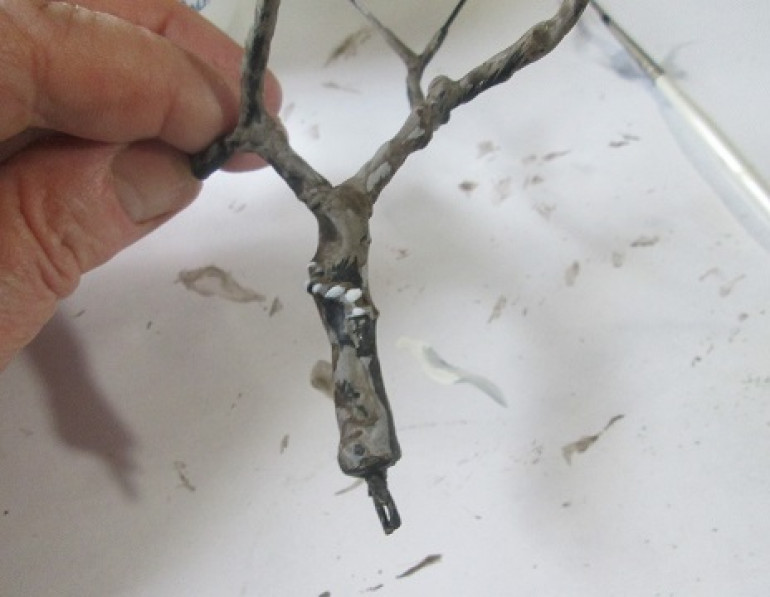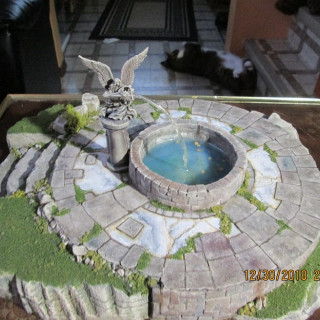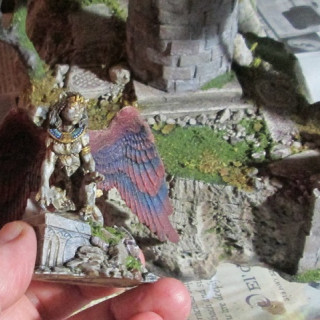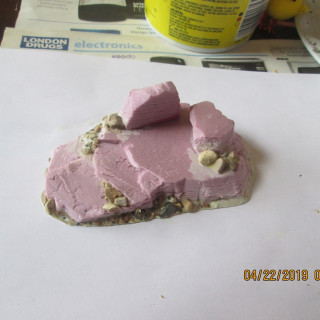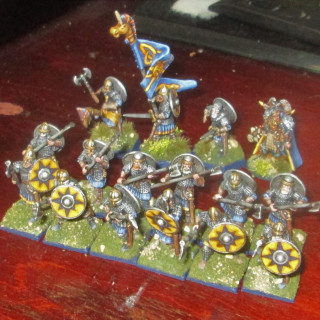
Battle Boards and Scatter Terrain
Recommendations: 241
About the Project
Last fall my LGS convinced me to build battle boards and terrain for their new store. It was a project that went from ‘a few boards’ as we ordered our first pints, to a monster undertaking where I somehow agreed to produce two 4’ by 6’ tabletops and accompanying scatter terrain.
Related Genre: Fantasy
This Project is Active
Battle Boards and Scatter Terrain
I changed things up a bit when constructing the second river board, as I had problems with the glycerin infused lichen reacting with the Realistic Water. I still applied the flock before pouring the acrylic, but waited till the river had cured before adding the rest of the ‘garnish’.
 I got a few more pictures of the process this go around. Here’s one of the bits of blister pack plastic I used to dam up the ends of the river. I sealed it up with the glue gun and a transparent glue stick. The glue all but disappears when you pour acrylic around it.
I got a few more pictures of the process this go around. Here’s one of the bits of blister pack plastic I used to dam up the ends of the river. I sealed it up with the glue gun and a transparent glue stick. The glue all but disappears when you pour acrylic around it. The board after four pours of Realistic Water. I had to crack a third bottle of the stuff. I saw some clear school glue the other day that was cheap as chips (the same stuff I used to eat as a kid), and apparently it dries clear as well. It's on my list of alternative water options to try. I painted fish on the second layer once again, using gun metal and a pearlescent highlight. They look better than my previous efforts on the other board.
The board after four pours of Realistic Water. I had to crack a third bottle of the stuff. I saw some clear school glue the other day that was cheap as chips (the same stuff I used to eat as a kid), and apparently it dries clear as well. It's on my list of alternative water options to try. I painted fish on the second layer once again, using gun metal and a pearlescent highlight. They look better than my previous efforts on the other board. Garnish and Water Effects added. It's in the process of clearing... finicky stuff. If I was better with a glue gun I would try making waves with it next time. Also, I would submerge untreated lichen into the bank. Some drops of acrylic hit the island, but I covered them with flock.
Garnish and Water Effects added. It's in the process of clearing... finicky stuff. If I was better with a glue gun I would try making waves with it next time. Also, I would submerge untreated lichen into the bank. Some drops of acrylic hit the island, but I covered them with flock. Update on the first board: the Water Effects has almost cleared entirely, and the customer is very happy with how the board turned out... even the murky bits from the glycerin. I've never had a mistake called "mysterious" before, but I'll take that save.
Update on the first board: the Water Effects has almost cleared entirely, and the customer is very happy with how the board turned out... even the murky bits from the glycerin. I've never had a mistake called "mysterious" before, but I'll take that save.I learned a lot from these boards: use Water Effects sparingly, and do multiple layers to build it up, just as you would with Realistic Water. Make sure to use clean lichen if you’re going to submerge it in the water.
These boards warped ever so slightly when the acrylic cured, despite having been weighted down on all four corners. Not sure what the solution is. In the past I’ve straightened things out by painting the bottom of the board afterward. Then, as the paint dries it pulls the board flat again. I may give it a try.
I’m on to the flat boards next. They should go fairly quickly. I may sculpt remnants of a walk, or building foundations into the foam, but I’ll keep the features small enough so they can be covered with a hill.
Battle Boards and Scatter Terrain
It’s been a while since I’ve been able to post on this project. Funny how life gets in the way. As mentioned previously, I’ve moved on to the battle boards themselves, and of course started with the most difficult ones: the two river boards. Needless to say, things didn’t go quite as planned… but I keep telling myself this is all a learning experience and will aid me in building the next set — bullsh*t.
 Two river boards, one with an island. After carving out the channel I lined it with wall filler, both to protect the foam in case the Woodland Scenics stuff ate it, and also to texture the bottom (I didn't like the texture and ended up sanding it smooth). I also used polystyrene to make some larger rocks for the banks and river bed. The foam has warped on the island board, but I'll weigh it all down on a flat level surface when I do the first pour of Realistic Water.
Two river boards, one with an island. After carving out the channel I lined it with wall filler, both to protect the foam in case the Woodland Scenics stuff ate it, and also to texture the bottom (I didn't like the texture and ended up sanding it smooth). I also used polystyrene to make some larger rocks for the banks and river bed. The foam has warped on the island board, but I'll weigh it all down on a flat level surface when I do the first pour of Realistic Water.  Paint: I tried to force perspective, or in this case, depth by painting the middle of the channel a darker green.
Paint: I tried to force perspective, or in this case, depth by painting the middle of the channel a darker green. 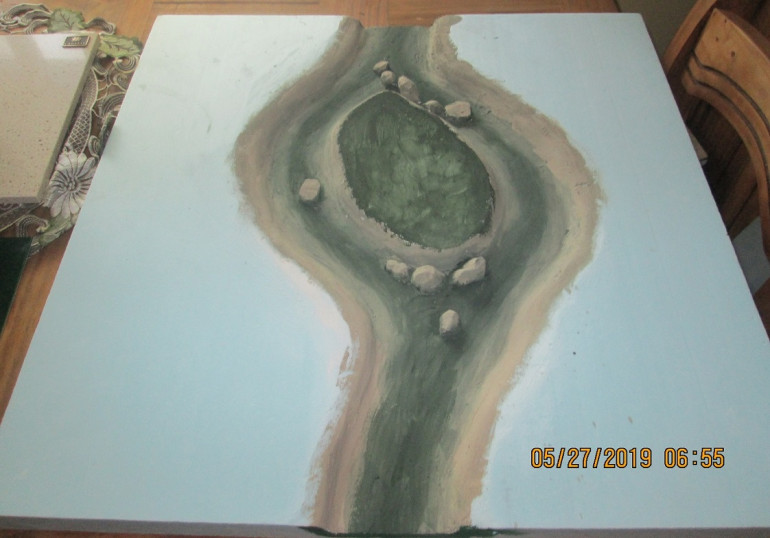 The island board. Note to self: make the @#$%! island big enough next time so that a copse will fit on it.
The island board. Note to self: make the @#$%! island big enough next time so that a copse will fit on it. Both boards were drybrushed with a lighter tan so all the stones would look similar, but there's still enough variation in the underlying natural colours to add interest. I put in two flat stones to either side of the island to act as a possible ford. They'll still be covered with water, but will be visible, so it will be up to the players to decide whether or not the fords are in play.
Both boards were drybrushed with a lighter tan so all the stones would look similar, but there's still enough variation in the underlying natural colours to add interest. I put in two flat stones to either side of the island to act as a possible ford. They'll still be covered with water, but will be visible, so it will be up to the players to decide whether or not the fords are in play. I managed to score eight plasticard signs from a local gas station that were used for a promotion. I got them before they went into the bin, so I didn't even have to go dumpster diving, though I would have (saved $25). I cut out a section of the plasticard where the river ends, and will use clear blister pack plastic to dam it up. Note the plastic putty knife, used it to flatten out the hot glue beneath the plasticard.The top edge got a healthy dose of wood glue and wall filler to seal up the gap, as with the previous small edge pieces.
I managed to score eight plasticard signs from a local gas station that were used for a promotion. I got them before they went into the bin, so I didn't even have to go dumpster diving, though I would have (saved $25). I cut out a section of the plasticard where the river ends, and will use clear blister pack plastic to dam it up. Note the plastic putty knife, used it to flatten out the hot glue beneath the plasticard.The top edge got a healthy dose of wood glue and wall filler to seal up the gap, as with the previous small edge pieces. The two boards got a dark green shadow where flock will be glued down. I've watered down the craft paint considerably because A: it covers easier, and B, I'm a cheap bastard and want to stretch my paint as far as I can. In my experience it hasn't really mattered if the coverage isn't perfect. I might add that Innis and Gunn Lager is ideally suited to building river boards
The two boards got a dark green shadow where flock will be glued down. I've watered down the craft paint considerably because A: it covers easier, and B, I'm a cheap bastard and want to stretch my paint as far as I can. In my experience it hasn't really mattered if the coverage isn't perfect. I might add that Innis and Gunn Lager is ideally suited to building river boards  Flock added. I had some smaller bits of lichen left that had already been treated with glycerin, so lined the bank with it. Little did I know that the acrylic water would react with it and turn white. #$%^&! Also, there are some glaring gaps in my flock coverage. It reminds me of the haircuts my dad used to give me to save money. I'll patch it up when everything has cured.
Flock added. I had some smaller bits of lichen left that had already been treated with glycerin, so lined the bank with it. Little did I know that the acrylic water would react with it and turn white. #$%^&! Also, there are some glaring gaps in my flock coverage. It reminds me of the haircuts my dad used to give me to save money. I'll patch it up when everything has cured. First pour. Note the clear blister plastic at both ends of the river. I tinted the water with a drop of blue tone per 2 oz. of acrylic. It looks much greener in real life. I've weighed down the four edges so they don't lift when the acrylic cures. I used an entire bottle of Realistic Water on this board, even though I tried to keep the river's dimensions modest. You could always muddy the water so you can't see the bottom (by using a drop of paint instead of wash) and thereby make it much shallower and wider. I should apologize here for the book titles; they're from my spouse's shelf.
First pour. Note the clear blister plastic at both ends of the river. I tinted the water with a drop of blue tone per 2 oz. of acrylic. It looks much greener in real life. I've weighed down the four edges so they don't lift when the acrylic cures. I used an entire bottle of Realistic Water on this board, even though I tried to keep the river's dimensions modest. You could always muddy the water so you can't see the bottom (by using a drop of paint instead of wash) and thereby make it much shallower and wider. I should apologize here for the book titles; they're from my spouse's shelf. I painted fish on the first layer when it cured, using silver and a pearlescent highlight then did two more pours. Looks good now but everything went pear shaped when I added the Water Effects paste.
I painted fish on the first layer when it cured, using silver and a pearlescent highlight then did two more pours. Looks good now but everything went pear shaped when I added the Water Effects paste.  I put in a small section of waves using Water Effects. It dried clear, as advertised, but looked a bit messy, and the waves weren't tall enough, so I added more, and thought it would be a good plan to add a final layer of Realistic Water to clean it all up. I sculpted higher waves all along the river, but after several days the goop hadn't cleared completely. I got impatient with the mess surrounding the sculpted waves, so did the final pour. All the Water Effects paste turned white again! I'm told it will all eventually clear up, and it has somewhat after a few days in the sun, but confidence is low. The whole thing came very close to going into the bin! Note the white where the glycerin reacted with the Realistic Water. I'll either cover it with more lichen (using wood glue to stick it down this time) or put some bright green flock over the area as pond scum. The plan was to make the river non-directional, as the two boards will fit together in several different configurations. It just wouldn't look right to have the river flowing in two directions! Next: I'll post pics of the island board when I finish it.
I put in a small section of waves using Water Effects. It dried clear, as advertised, but looked a bit messy, and the waves weren't tall enough, so I added more, and thought it would be a good plan to add a final layer of Realistic Water to clean it all up. I sculpted higher waves all along the river, but after several days the goop hadn't cleared completely. I got impatient with the mess surrounding the sculpted waves, so did the final pour. All the Water Effects paste turned white again! I'm told it will all eventually clear up, and it has somewhat after a few days in the sun, but confidence is low. The whole thing came very close to going into the bin! Note the white where the glycerin reacted with the Realistic Water. I'll either cover it with more lichen (using wood glue to stick it down this time) or put some bright green flock over the area as pond scum. The plan was to make the river non-directional, as the two boards will fit together in several different configurations. It just wouldn't look right to have the river flowing in two directions! Next: I'll post pics of the island board when I finish it.Battle Boards and Scatter Terrain
A short entry this week. I’ve moved on to the boards themselves, but in the spirit of potentially f-cking things up royally, I’ve started with the small edge pieces before moving on to the more costly ‘2 by 2’ boards.
The plan, at the moment of conception, was to put duct tape along the edges to protect them from bumps and bangs. I applied it to a scrap to see how it looked and the first word that came to mind was ‘tacky’.
I then moved on to plasticard. I sprayed it with a Hunter Green primer, which ended up being shiny, but everything will be sprayed with a matt sealer eventually, so no big deal.
 I sprayed the plasticard with Hunter Green primer then cut it into 1 1/2" wide strips. I applied hot glue to a corner, and made sure the edges of the plasticard lined up top and bottom all the way along the edge. You've only got a few seconds to do this before your hot glue sets. Then I worked my way along, gluing small segments at a stretch. Note: a credit card or spatula is ideal for pushing the glue along and squeezing it flat beneath the plasticard, ensuring a snug, flat fit. The corners were trimmed and sanded, and I used glue and wall goop to fill in tiny crevices between the polystyrene and plastic.
I sprayed the plasticard with Hunter Green primer then cut it into 1 1/2" wide strips. I applied hot glue to a corner, and made sure the edges of the plasticard lined up top and bottom all the way along the edge. You've only got a few seconds to do this before your hot glue sets. Then I worked my way along, gluing small segments at a stretch. Note: a credit card or spatula is ideal for pushing the glue along and squeezing it flat beneath the plasticard, ensuring a snug, flat fit. The corners were trimmed and sanded, and I used glue and wall goop to fill in tiny crevices between the polystyrene and plastic. I could tell, even at this stage, that the pieces were going to be quite versatile, both for their original purpose, which was to flank a slope board sandwiched between two flat boards, and also for putting together unique terrain features. They can be used as a ridge on a board edge, or put together as a finger of land jutting in from a side.
I could tell, even at this stage, that the pieces were going to be quite versatile, both for their original purpose, which was to flank a slope board sandwiched between two flat boards, and also for putting together unique terrain features. They can be used as a ridge on a board edge, or put together as a finger of land jutting in from a side. I painted on a tan base coat, as per previous models. Note the beefed up glue/wall filler base, which will hopefully toughen it up a bit.
I painted on a tan base coat, as per previous models. Note the beefed up glue/wall filler base, which will hopefully toughen it up a bit. Green base colour painted on to areas that will be covered in flock or lichen. I slopped a dark brown wash on tan areas and added yellow to the orginal tan as a highlight.
Green base colour painted on to areas that will be covered in flock or lichen. I slopped a dark brown wash on tan areas and added yellow to the orginal tan as a highlight. I added flock and foliage to the pieces, and was quite happy with the result, particularly along the edges where the flock further covers the seam between the foam and protective plastic.
I added flock and foliage to the pieces, and was quite happy with the result, particularly along the edges where the flock further covers the seam between the foam and protective plastic. I'm quite happy with how these pieces butt together. I can only hope the rest of the boards fit together as well.
I'm quite happy with how these pieces butt together. I can only hope the rest of the boards fit together as well.Lessons learned: Plasticard is definitely the way to go when edging boards. It’s cheap and will protect the board edge quite well. I find that gluing it on straight along an edge is a challenge, but I think applying it in shorter segments might help. You can always trim it up afterward, and you can also sand plasticard, as I found out during this test run.
I went with a complimentary green colour for the edge. I would likely go with a red/brown on a desert board, or a dark purple or navy blue on some sort of greyscale lunar landscape… anything that says “This is not part of the playable area.” It should also be darker than the predominant colour on the boards, otherwise it will draw attention from your meticulously crafted terrain!
Next installment: river boards. Mediocrity is within my grasp.
Battle Boards and Scatter Terrain
 I finished up the other three hills but things didn't go quite as planned. As mentioned previously, I wanted the copses to stack on top of the hills, but I got a bit overzealous in carving the hills, and now the copses are a squeeze on two of the hills, and won't fit on the third. $%^&*#!
I finished up the other three hills but things didn't go quite as planned. As mentioned previously, I wanted the copses to stack on top of the hills, but I got a bit overzealous in carving the hills, and now the copses are a squeeze on two of the hills, and won't fit on the third. $%^&*#!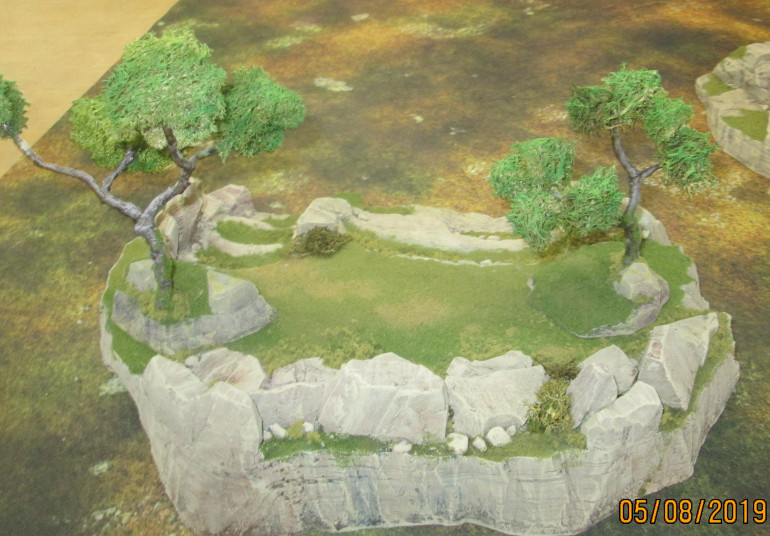 I wanted this hill to be a good defensive position, and so stacked rocks on one edge. I carved a rocky slope/stairs on the back side of the hill so troops could move into position quickly. Unfortunately, none of the copses will fit on it. It will, however, hold a few individual trees... almost like I planned it.
I wanted this hill to be a good defensive position, and so stacked rocks on one edge. I carved a rocky slope/stairs on the back side of the hill so troops could move into position quickly. Unfortunately, none of the copses will fit on it. It will, however, hold a few individual trees... almost like I planned it. The next hill had a rocky access on one side, and a gentle slope on the other. I used a few different kinds of flock, and will likely forego sand altogether as ground cover on the rest of the project. The Woodland Scenics Earth Blend contrasts well with the other flocks I'm using..
The next hill had a rocky access on one side, and a gentle slope on the other. I used a few different kinds of flock, and will likely forego sand altogether as ground cover on the rest of the project. The Woodland Scenics Earth Blend contrasts well with the other flocks I'm using.. The other side of the same hill showing the slope. Note: individual trees are a better fit... like I planned it. @#$%^&!
The other side of the same hill showing the slope. Note: individual trees are a better fit... like I planned it. @#$%^&! The last hill had more real estate on the top, thanks to my last experiment with building a wall section. A copse fits nicely on top.
The last hill had more real estate on the top, thanks to my last experiment with building a wall section. A copse fits nicely on top. I fiddled with brick size again on this wall, but am on the fence about whether I will use this method to build an entire castle. If I do, I will use more larger bricks where possible. This will get another wash at the finishing stage to darken it somewhat.
I fiddled with brick size again on this wall, but am on the fence about whether I will use this method to build an entire castle. If I do, I will use more larger bricks where possible. This will get another wash at the finishing stage to darken it somewhat.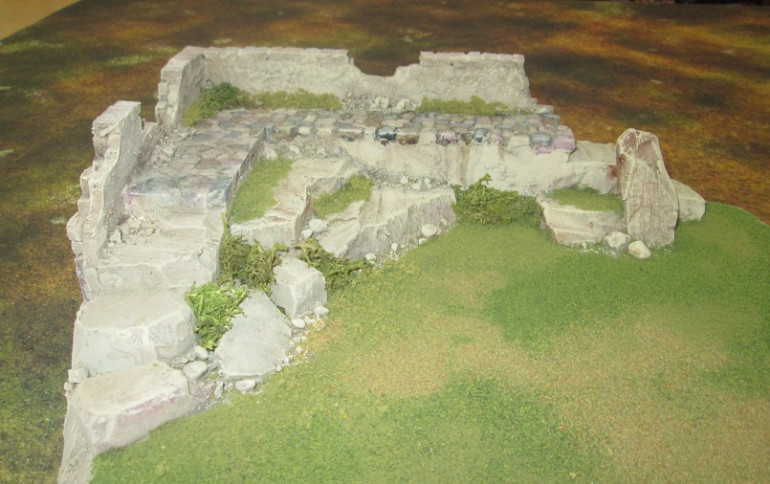 I like how this side of the wall turned out, combining natural and ruined architectural elements. This would make a great overwatch position, with room for half a dozen models. It could use more foliage, and some paint touch-ups, as the bricks are too saturated in places.
I like how this side of the wall turned out, combining natural and ruined architectural elements. This would make a great overwatch position, with room for half a dozen models. It could use more foliage, and some paint touch-ups, as the bricks are too saturated in places.Overall I was a bit disappointed with these pieces. If I got a ‘do over’ I would have been more cognizant of copse and hill size. On the next set (I have an order for another one) I will likely match each copse to a hill, but still make them versatile enough to be switched up a bit. Next week I’ll post pics of my edge pieces, and my first kick at covering the sides of the boards in plasticard,
Unrelated, but I think I found a kindred spirit at work. Love this doctored ‘Wet Floor’ sign!
Battle Boards and Scatter Terrain
 Thought I'd share this. While building the battle boards I've been concurrently working on a few units for a brigade-sized Battlesystem scrum to baptize the terrain. This rock troll will be a bad guy PC. He was the Reaper free mini with $10 purchase for the month of March. I cammed him to look like a snow-covered rock.
Thought I'd share this. While building the battle boards I've been concurrently working on a few units for a brigade-sized Battlesystem scrum to baptize the terrain. This rock troll will be a bad guy PC. He was the Reaper free mini with $10 purchase for the month of March. I cammed him to look like a snow-covered rock.Battle Boards and Scatter Terrain
 I stuck the tree into the base with a glue gun and added some glue as 'roots,' to help keep it in place. It doesn't look much like roots at this stage, but I'll hide this ham fisted effort with paint and weeds.
I stuck the tree into the base with a glue gun and added some glue as 'roots,' to help keep it in place. It doesn't look much like roots at this stage, but I'll hide this ham fisted effort with paint and weeds.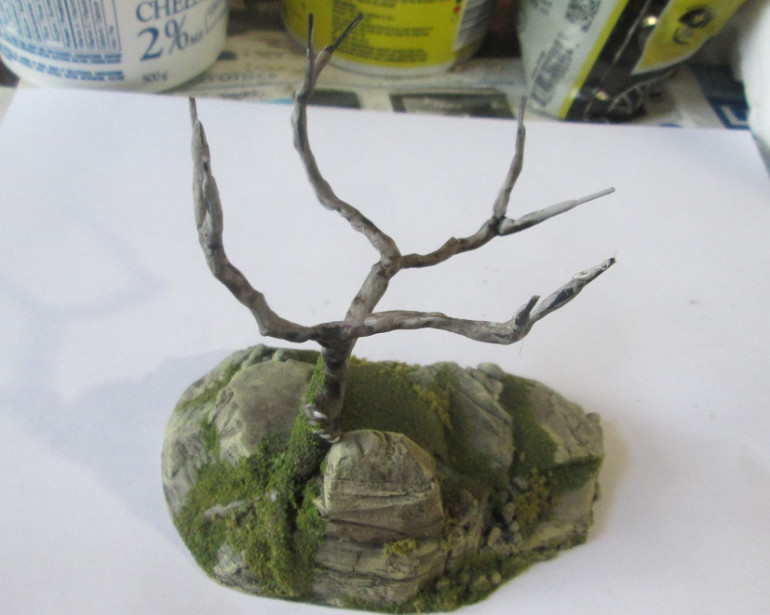 I painted the roots then added foliage to the base, again a few different Woodland Scenics products. If you're skinnt you need look no further than your spice cupboard for small amounts of ground cover. Thyme, parsley, and oregano are all great choices for adding variety and texture. I once had a player whose favourite colour was 'paprika,' so upon request, the base of her miniature was covered in the stuff... artists *Shakes head.*
I painted the roots then added foliage to the base, again a few different Woodland Scenics products. If you're skinnt you need look no further than your spice cupboard for small amounts of ground cover. Thyme, parsley, and oregano are all great choices for adding variety and texture. I once had a player whose favourite colour was 'paprika,' so upon request, the base of her miniature was covered in the stuff... artists *Shakes head.* Time to add lichen. I sprayed it down with glycerin, mixed roughly 1:1 with water. Otherwise it flows like urine around a grapefruit sized prostrate.
Time to add lichen. I sprayed it down with glycerin, mixed roughly 1:1 with water. Otherwise it flows like urine around a grapefruit sized prostrate. The final step was to apply the foliage with a glue gun, and drybrush a leaf green on it where it had faded to brown in the bag (actually, that's two steps). It's not quite the colour I wanted, but at the finishing stage, all the deciduous trees will get a slightly yellower highlight.
The final step was to apply the foliage with a glue gun, and drybrush a leaf green on it where it had faded to brown in the bag (actually, that's two steps). It's not quite the colour I wanted, but at the finishing stage, all the deciduous trees will get a slightly yellower highlight.That’s all for this week. I hope this fills in any gaps in the process. Next week I’ll move on to the remaining hills, and illustrate the dreaded three ‘P’s of terrain building: piss poor planning.
Battle Boards and Scatter Terrain
This week I thought I would go step by step in creating an individual tree and base. I’ve described the process with other pieces, but I haven’t actually illustrated it. The steps are pretty much the same for larger hills and such, so hopefully this will fill in the blanks.
As stated previously, I didn’t think I had planned for enough terrain to stock two 4′ by 6′ tables, so I created half a dozen individual trees to keep the client smiling.
There weren’t many parameters for these bits; I wanted them to still provide cover for at least one model, and maybe have enough room on the base for a second model.
 I've already described the process of building trees out of wire, so we'll start there. This piece was primed with 'rattle can black.' I use whatever primer I have on hand for projects like this, usually Krylon. Sometimes they dry with a satin or even a gloss finish, which leads me to wonder what tall forehead thought to label it 'primer,' when nothing else will stick to it. In this case I sprayed my glossy tree with a matt fixative.
I've already described the process of building trees out of wire, so we'll start there. This piece was primed with 'rattle can black.' I use whatever primer I have on hand for projects like this, usually Krylon. Sometimes they dry with a satin or even a gloss finish, which leads me to wonder what tall forehead thought to label it 'primer,' when nothing else will stick to it. In this case I sprayed my glossy tree with a matt fixative. Base colour is a light grey/brown craft paint. Note that I didn't cover it entirely, so there are random dark patches, which could represent running sap, black knot fungus (whick looks like a turd on a stick) or just variations in the bark itself. For birch and poplar I would have gone with white at this stage.
Base colour is a light grey/brown craft paint. Note that I didn't cover it entirely, so there are random dark patches, which could represent running sap, black knot fungus (whick looks like a turd on a stick) or just variations in the bark itself. For birch and poplar I would have gone with white at this stage.  I added a dark brown wash, but again I didn't cover it entirely, allowing for different shades on the bark. This was either Agrax or Army Painter strong tone; I can't remember which. You won't go broke using a commercial wash on trees. Rather than drybrush the tree, I saved a step and just wiped away some of the wash with my thumb to create a highlight.
I added a dark brown wash, but again I didn't cover it entirely, allowing for different shades on the bark. This was either Agrax or Army Painter strong tone; I can't remember which. You won't go broke using a commercial wash on trees. Rather than drybrush the tree, I saved a step and just wiped away some of the wash with my thumb to create a highlight. Time to set the tree aside to dry, and get to work on the base. I started with some scrap 1/2" polystyrene
Time to set the tree aside to dry, and get to work on the base. I started with some scrap 1/2" polystyrene I glued the rocks to the base with a glue gun, but you can use PVA glue as well. Just allow plenty of time for the glue to set. I've cracked open pieces I've had for years, out of curiosity, and still found wet glue inside!
I glued the rocks to the base with a glue gun, but you can use PVA glue as well. Just allow plenty of time for the glue to set. I've cracked open pieces I've had for years, out of curiosity, and still found wet glue inside!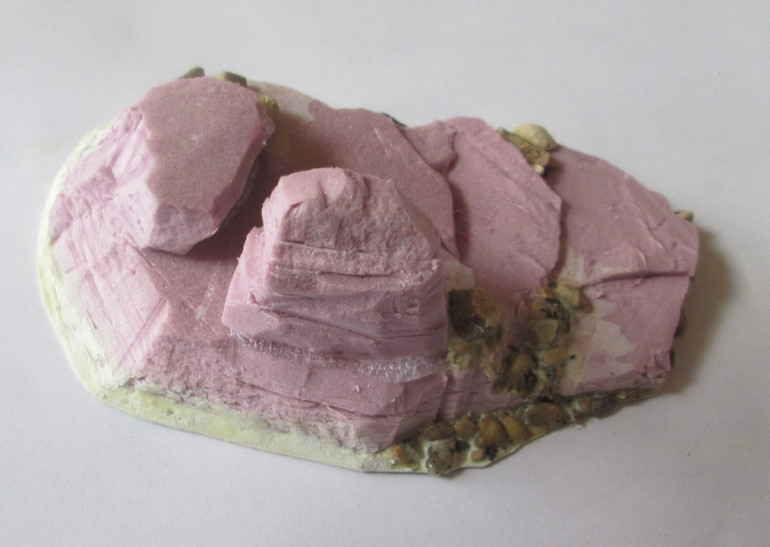 I trimmed up the plastiicard, but decided to extend it beyond 1/16" in places so I could place gravel at ground level around the piece. The base won't withstand re-entry, but it should be a bit more game proof. Note the wall filler on the base, with a layer of PVA glue applied over top... another attempt to toughen up my terrain.
I trimmed up the plastiicard, but decided to extend it beyond 1/16" in places so I could place gravel at ground level around the piece. The base won't withstand re-entry, but it should be a bit more game proof. Note the wall filler on the base, with a layer of PVA glue applied over top... another attempt to toughen up my terrain.Battle Boards and Scatter Terrain
 This phase of the project started with a tree building marathon, a process that has already been described. Note the one item that didn't make it on to my initial supply list: a microbrewery.
This phase of the project started with a tree building marathon, a process that has already been described. Note the one item that didn't make it on to my initial supply list: a microbrewery.The remaining three copses were constructed with a few factors in mind: first, space for interaction between models; second, I wanted them to have enough cover to be defensible; third, I wanted them to be tall enough be an LOS obstacle (unlike the individual trees I built later); and fourth, I wanted each to have unique characteristics.
 The three remaining copses had unique characteristics. Again, I experimented with a ruined wall section.
The three remaining copses had unique characteristics. Again, I experimented with a ruined wall section.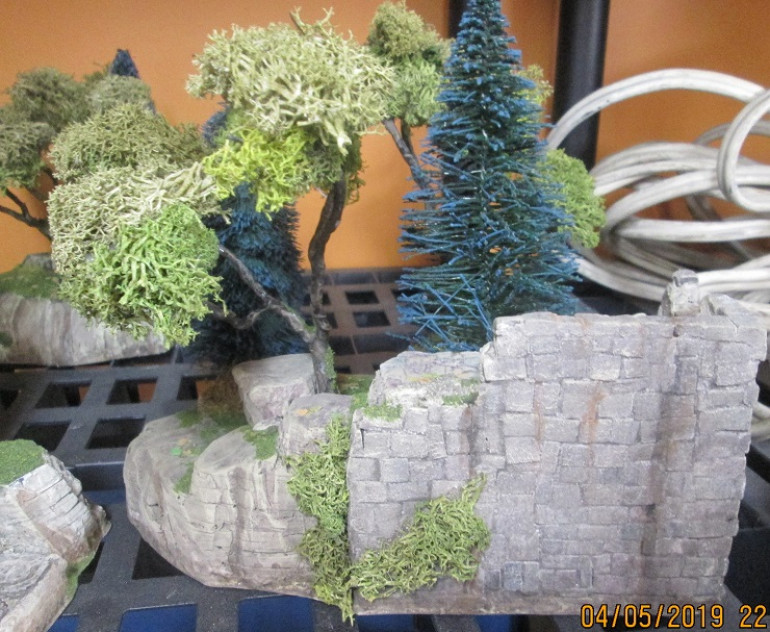 On this section of wall I tried a variation on the bricks. I tried to make them less uniform. It was a bit more of a challenge fitting them together, and I got the wash a bit too heavy, and lost a lot of the underlying colours.
On this section of wall I tried a variation on the bricks. I tried to make them less uniform. It was a bit more of a challenge fitting them together, and I got the wash a bit too heavy, and lost a lot of the underlying colours. Opposite view, showing the natural rock shelf access. Note that some of the foliage has lost its colour. It will get a green drybrush at the end.
Opposite view, showing the natural rock shelf access. Note that some of the foliage has lost its colour. It will get a green drybrush at the end.On the next hill I glued polystyrene scraps to the edge of the piece before sculpting it. I was hoping to create a more dramatic rock face. As with the previous brick ruin copse, this piece offers good cover for several models, and would be a good anchor for a flank, or a good overwatch position.
 Scrap and base sculpted to create a higher feature. Not entirely happy with it. Next time I will make it less smooth, and possibly more complex. Also, the base will need more angles; I can still see the 'square' shape of the orginal block of polystyrene. Not many straight lines in nature. Like a good book, good terrain should suspend disbelief.
Scrap and base sculpted to create a higher feature. Not entirely happy with it. Next time I will make it less smooth, and possibly more complex. Also, the base will need more angles; I can still see the 'square' shape of the orginal block of polystyrene. Not many straight lines in nature. Like a good book, good terrain should suspend disbelief. This copse was accessed by a ramp that curved around the outer edge. The angle on the slope was shallow enough for the average model, but the tippy ones, not so much.
This copse was accessed by a ramp that curved around the outer edge. The angle on the slope was shallow enough for the average model, but the tippy ones, not so much. The last copse had a more open top, and was also accessed by rock shelf steps. I put a few rocks on it for cover, and scattered leaves on the ground, as with all the other copses.
The last copse had a more open top, and was also accessed by rock shelf steps. I put a few rocks on it for cover, and scattered leaves on the ground, as with all the other copses.One thing I failed to mention with regards to the coniferous trees: I’ve encountered two kinds of bases, one with a wooden disc, and the other with a sloped plastic base. I prefer the plastic base — it can be left on and covered with Spanish moss, as the area under the tree is wasted space anyway. The wooden disc is harder to camouflage, so I remove them and sculpt a trunk out of Milliput.
Overall I was happy with how these pieces turned out, and learned a few lessons about carving polystyrene, and how to design these smaller pieces so that they are interesting and more than just an LOS block.
Next week I’ll post pics of the individual trees I built for this project.
Battle Boards and Scatter Terrain
Next week I’ll post pics of the remaining copses, and fill in any blanks in terms of process before moving on to the hills. If you have any questions, ask away.
Battle Boards and Scatter Terrain
Copse Prototype
I’m back with another piece for the battle boards and scatter terrain project I got roped into.
The idea behind the copse was to put a bunch of trees on a 1½” thick base that was smaller than the hill features, and could actually be stacked on them (with the exception of the fountain hill already described) to make a more dramatic elevated bit of terrain. From experience I also know that multiple trees on a larger base are less tippy.
I decided to go with two deciduous and two coniferous trees on each base. Coniferous trees take up a lot of real estate so I didn’t want to squeeze in more than that, or there wouldn’t have been any room for models to interact, or room for other features that could be used as cover.
Every Christmas I stock up on pine trees at the dollar store. They are trimmed bottle brushes, more or less, and are often covered in some kind of white flock… but the price is right. I scrub off the ‘snow’ as best I can with soap and hot water, and then prime them black with a rattle can (vigilance alert. It takes a lot of spray to get rid of that ridiculous light green colour). I then get down about halfway into the bristles with a fat brush loaded with dark green paint. That way the ‘trunk’ stays black/shadowed.
At this point you can brush PVA glue on the outer boughs, like a drybrush, and then throw green flock at it to get a better pine tree texture, but it’s optional. I didn’t on any trees in this project and they still look fine, but may try it next time. The final step is to drybrush a lighter blue/green on the boughs to give them that ‘blue spruce’ look.
Deciduous trees are more work, and to make them out of wire requires dedication and two pairs of plyers. I cut four pairs of wire about 7-8” long, with one pair being longer than the others. This became the ‘root’ that was jammed into the base and stuck in with a glue gun — part of my robust build strategy. It would take considerable incompetence or wilful malice to pull one out.
 Deciduous tree build. The longer pair will form the root that gets stuck into the polystyrene and held in place with a glue gun.
Deciduous tree build. The longer pair will form the root that gets stuck into the polystyrene and held in place with a glue gun.I twisted the pairs together, leaving an inch or so of wire separated at the top. This was the final fork where I glued on foliage. The two pairs were wound together but l left room at the top for the pairs to branch out… literally. I twisted the long pair of wires with the remaining shorter one so that the two longer strands stuck out of the bottom. All four pairs went together, leaving the two long strands at the bottom, and a split trunk further up.
Putty: as stated previously, I used Milliput to fill out the trees but you can use any two-part epoxy, or even an air-dry compound like DAS. The idea, when applying the putty, is to preserve the twisted look of the wires, so it becomes part of the sculpt, and not just part of the frame.
I primed the trees black and applied a grey/brown base colour, washed with Agrax Earthshade – or ‘Artist in a Jar’ – as it is more commonly known, and then drybrushed with a lighter grey. Finally, I added green flock to the trunk, to mimic the moss that coats trees in a temperate forest.
Foliage: I used lichen but you can also use the shredded green foam. It’s a matter of personal preference in the end. The client preferred lichen, and so do I, but it does require some care and feeding. Glycerin, available at most drug stores, will keep the lichen moist and pliable; I mixed it 1:1 with water so it could be applied with a spray bottle; it is quite viscous otherwise. I stuck the lichen on with a glue gun, and in some instances, drybrushed a light green on it, as the colour can fade if it’s been in the bag for a while.
 DAS is a cheap alternative to Green Stuff or Milliput. I've used it here with a Green Stuff rolling pin to make steps and a walkway, but it can also be used to make custom bases.
DAS is a cheap alternative to Green Stuff or Milliput. I've used it here with a Green Stuff rolling pin to make steps and a walkway, but it can also be used to make custom bases.For this piece I used DAS and a Green Stuff Celtic rolling pin to make the stairs and paved area before the statue. I just rolled it out till it was about 3/16” thick, waited for it to dry (1-2 days), and then cut it as needed (it will distort if you try to cut it when it’s wet). The pieces were stuck in place with wood glue and the gaps sealed up with wall filler. You’ll see them better after a wash and drybrush.
The pillar was made with a toilet paper roll, minus the bum wad of course. I used the same brick technique I fiddled with on the fountain, and put in a bit of a wall ruin on one edge as well. The statue was an old AD&D golem I had lying around, but it didn’t come across dramatic enough, or large enough for the plinth, so I replaced it with a Bones model.
The trees were placed so that models could still interact between them and under them. I angled the deciduous trees outward so they wouldn’t take up space on the terrain piece, but at the same time there was still enough room for models underneath them on the table… the whole game table vs. diorama thing once again.
Note the 1/16” plasticard edge on the base (I couldn’t fit the image in here. See the gallery in the first post). I put a layer of wall filler there as a buffer against accidental bumps and bruises. Wood glue stiffened up the edge further, and will keep the wall filler from crumbling if it takes a hit.
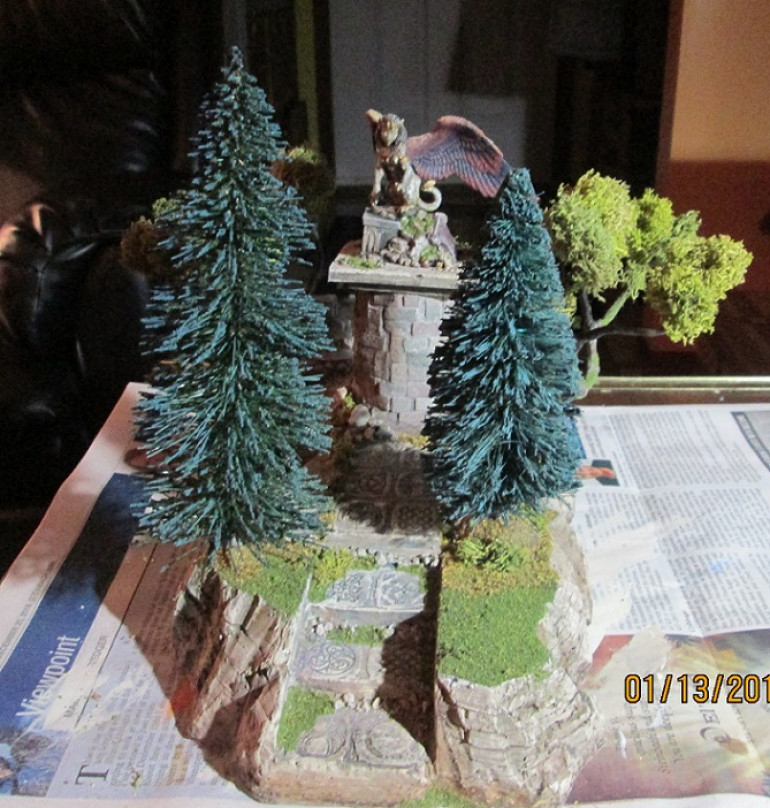 Front view showing angled trees and available space for models both on the piece and beneath the boughs on the tabletop.
Front view showing angled trees and available space for models both on the piece and beneath the boughs on the tabletop. Forest floor made from assorted Woodland Scenics turf, Spanish moss, gravel, and leaves made with a Green Stuff leaf cutter. I used painted paper but actual leaves work better. Unfortunately all ours were buried under three feet of snow when I made this piece.
Forest floor made from assorted Woodland Scenics turf, Spanish moss, gravel, and leaves made with a Green Stuff leaf cutter. I used painted paper but actual leaves work better. Unfortunately all ours were buried under three feet of snow when I made this piece.Gravel, grass and foliage were added. I painted up a Reaper Bones sphinx as a statue, with the same marble effect I used on the previous fountain board. I magnetized the platform and model for two reasons: first, in case someone wanted to animate the statue in a fantasy game, and second, so that it could be replaced with a statue of a space marine, Napoleon, or even an ACW general (only a Northern one, apparently). Pics in next entry.
Battle Boards and Scatter Terrain
On to the angel. I originally bought the Reaper angel to teach the missus how to paint hair, feathers, and robes, all in one go. Needless to say, that plan went south. But the model was ideal for my fountain, and as luck would have it, the hands were perfectly placed to hold an amphora, which was made from Milliput, a paper clip, and a GW high elf bit. The pedestal is a thread spool nicked from my partner’s sewing room.
 GW angel with amphora made from Milliput, a paper clip, and a GW elf bit. Note the leaves in the water. They were made with a Green Stuff leaf cutter and painted paper.
GW angel with amphora made from Milliput, a paper clip, and a GW elf bit. Note the leaves in the water. They were made with a Green Stuff leaf cutter and painted paper.Water Effects
My original intent was to look for a cheaper alternative to Woodland Scenics Realistic Water (hereafter WSRW) for the pool itself, but in the end, that’s what I went with. I picked up some two-part five minute epoxy syringes, but there was far less in them than I thought there would be. I injected one into the fountain and it barely covered the bottom… grrr.
My next ill-conceived venture involved casting resin, which was marginally cheaper than WSRW. I poured about ¼” of the stuff into the fountain and left it for a day… then two… then three. The smell left us higher than kites – and it never did set. No one told us we needed to mix in a catalyst… duh. It also eats foam. I finally just bit the bullet and poured ¼” of WSRW over it.
I tinted the WSRW with a drop of blue ink (ink will tint the water, but leave it transparent, while a drop of paint will make it murky). After 24 hours it was mostly set, so I dumped in some leaves made with the Green Stuff leaf cutter. I did a final ¼” clear pour of WSRW and added more leaves so that it would look like they were dispersed throughout the water column.
The stream from the amphora was made with half a dozen bits of fishing line stuck together at one end with Superglue and stuffed into the amphora (fiddly bits profanity alert). The other ends were splayed and arced into the water, then glued to the surface. I mixed up one of the syringes of five minute epoxy, and applied it to the strands with a Kamikaze brush.
I made emanating waves with Woodland Scenics Water Effects, which starts life as a white paste, but dries transparent. It also has a 24-hour set time, so can be sculpted into ripples and waves without the manic frenzy of a five-minute epoxy. If you’re good with a glue gun, you can also sculpt the transparent goop into waves, but you’ll have even less time to mold it into something approaching a wave.
 Waves made with Woodland Scenics Water Effects were stippled with white then painted over with WSRW to give the white a gloss finish.
Waves made with Woodland Scenics Water Effects were stippled with white then painted over with WSRW to give the white a gloss finish. You can use a dry brush or stipple brush to apply white foam to the crests of the waves, but you’ll need to paint on WSRW or another glossy finish afterward.
Finally, I added four wedding cake pillars to the back of the fountain, and placed statues produced and donated by a friend at Legions IV Hire in Winnipeg. The lintels were made from scrap ½” polystyrene from a previous project.
I’ve glossed over a lot of the processes used in this first scatter terrain piece, but I’ll cover them in next week’s instalment where I build the first copse, with an enchanted statue nestled in its depths.
Battle Boards and Scatter Terrain
Initial Cuts
A table saw is a must at this stage, as it is almost impossible to make vertical cuts with a knife or hot wire, and you will need those cuts to be vertical to make your boards butt together properly. The only alternative I can offer is that most stores (around here at least) that sell polystyrene insulation will also offer to cut it up for you for a marginal fee.
Looking back on the diagram, you’ll note that I have only cut three 2’ by 2’ boards out of each sheet, as the blade width on the table saw made the last portion under 2’. Instead, I cut the rest of the pieces out of the end of each board, as their dimensions didn’t need to be precise.
The ‘slope’ pieces will be carved and ‘stacked’ on top of four of the boards, along an edge. The pieces marked ‘edge’, roughly 3” by 11 ¾, can be used with a slope board if the boards to either side are flat. A pic will explain it better… I’ll post one when I get there.
 Vertical cuts are essential when building boards. Here are the four 'edge' pieces described earlier.
Vertical cuts are essential when building boards. Here are the four 'edge' pieces described earlier.Scatter Terrain
The first piece I wanted to work on was the fountain/hill, as it was a proof-of-concept for both colour palette and overall aesthetic (read ‘client approval’), and also a test for different materials. I would highly recommend fiddling with something small like this first, rather than destroying a larger board if things go pear shaped.
I started by drilling out a 3” hole for the fountain then cut the removed disk in half and reinserted one half as the floor of the fountain. I sealed it with wood glue, and then used a piece of foam core (with the paper removed from both sides) to make the round wall of the fountain.
I lined it all with wall filler, both for a textured cement finish, and also to prevent the foam from being turned to sludge by any of the water effects products I was testing. I finished off the inside with a dirty green wash for algae and put some rust and water staining above the eventual waterline.
It was only after I had carved the slopes and stairs, and started the brickwork that it occurred to me that someone might be interested in the process, so you’ll forgive me if the first pic shows a more advanced state than what I’ve described. A bit of backtracking may be in order:
I used a dinner plate to trace the platform around the fountain then carved the rest with a utility knife. I’ve found that a shallow cut, followed by a little leverage to snap off the piece, will yield a more natural looking rock face than simply cutting all the way through the foam. Save your foam scraps for rockwork.
For this build I went with a fractured sedimentary strata look, and therefore spent considerable time putting horizontal slashes into the slopes *Cue ‘Psycho’ shower scene music*. I started with a tan base colour, covered it in a dark brown wash that was tinted in places with red brown, navy blue, and purple. The final drybrush was the original tan lightened with yellow.
Platform: Initially I carved in some brickwork but wasn’t happy with it, so covered it up with plasticard bits to make it look like there was an ancient marble floor lurking beneath the crumbling tiles. I used a sepia wash to put a patina on the marble
 I wasn't happy with the brickwork on the edge of the platform, so covered it with plasticard 'tiles.' Another alternative would have been to fill in the sculpted bricks with wall filler.
I wasn't happy with the brickwork on the edge of the platform, so covered it with plasticard 'tiles.' Another alternative would have been to fill in the sculpted bricks with wall filler.Brickwork: a bit of experimentation here. All the castle pieces I’ve built to date have had the masonry carved right into the foam, but it always looked too smooth, and a bit unnatural. For this build I decided to make individual bricks — to see if the process was feasible for an entire castle.
I peeled the paper off one side of a piece of foam core then made bricks by cutting down to, but not through, the second layer of paper. The bricks got the same tan paint, tinted with various colours. They were peeled off the second layer of paper, and then applied randomly to the side and top of the fountain, and to the back of the hill, as if to shore up a weak slope.
 Bricks made from foam core board. The paper has been peeled away on one side, and cuts made down to, but not through, the bottom layer of paper.
Bricks made from foam core board. The paper has been peeled away on one side, and cuts made down to, but not through, the bottom layer of paper.The whole got a healthy dose of wall filler aka mortar, to fill in the spaces between the bricks. It dried very light, especially on the bricks themselves, so if you’re going to go this route, I suggest going over the surface of the bricks with a very damp cloth to get rid of as much of the filler as possible. The result at this point looked like new construction, but wasn’t the aged effect I was after. A wash dulled everything down, but left the individual brick colours visible – perfect.
Battle Boards and Scatter Terrain
This area will be reserved for pics that didn’t make it into the main article
Battle Boards and Scatter Terrain
 Plasticard. We won't be needing these signs anymore. The Canadian government just made cannabis legal.
Plasticard. We won't be needing these signs anymore. The Canadian government just made cannabis legal.10. Wall filler for joining foam pieces and fixing imperfections. Sand paper to smooth it all out.
11. Two 12 oz. bottles of Woodland Scenics Realistic Water (about $30 each).
12. One bottle of Woodland Scenics Water Effects for making waves and ripples ($17).
13. One 24” by 28” sheet of foam core poster board. As the name implies, it is a ¼” foam sheet sandwiched between two layers of paper (optional. You don’t need it if you’re not building brick wall ruins).
14. Soft bendable 1/16” wire for making tree armatures. Two-part epoxy to cover (I use Milliput).
15. 1″ and ½” brushes. A pack of dollar store brushes is fine. Most will end up in the bin anyway when you’re done with this. Also, a utility knife sharper than your mother-in-law’s tongue, along with a drawer full of extra blades.
16. A friend with a table saw who owes you money.
17. Other stuff as I think of it, or f_ck with it.
18. Patience… lots of patience
Battle Boards and Scatter Terrain
Last fall my LGS convinced me to build battle boards and terrain for their new store. It was a project that went from ‘a few boards’ as we ordered our first pints, to a monster undertaking where I somehow agreed to produce two 4’ by 6’ tabletops and accompanying scatter terrain. At some point, in a moment of clarity, I managed to come up with a PIDOOMA (pulled it directly out of my ass) on a cocktail napkin that was based on four sheets of 2’by 8’ polystyrene and a hockey sock full of hobby supplies. It looked something like this:
1. Twelve 2’ by 2’ game boards: six flat boards, four slope boards, and two river boards. The plan was for them to be geomorphic, in that they could fit together in a variety of ways.
2. Four hills, with one being a centerpiece with a fountain. More on the reasoning for that below.
3. Four copses, with one having a statue/plinth centerpiece.
4. Four small edge pieces to turn two back-to-back edge boards into a larger hill for ‘King of the Castle’ style games.
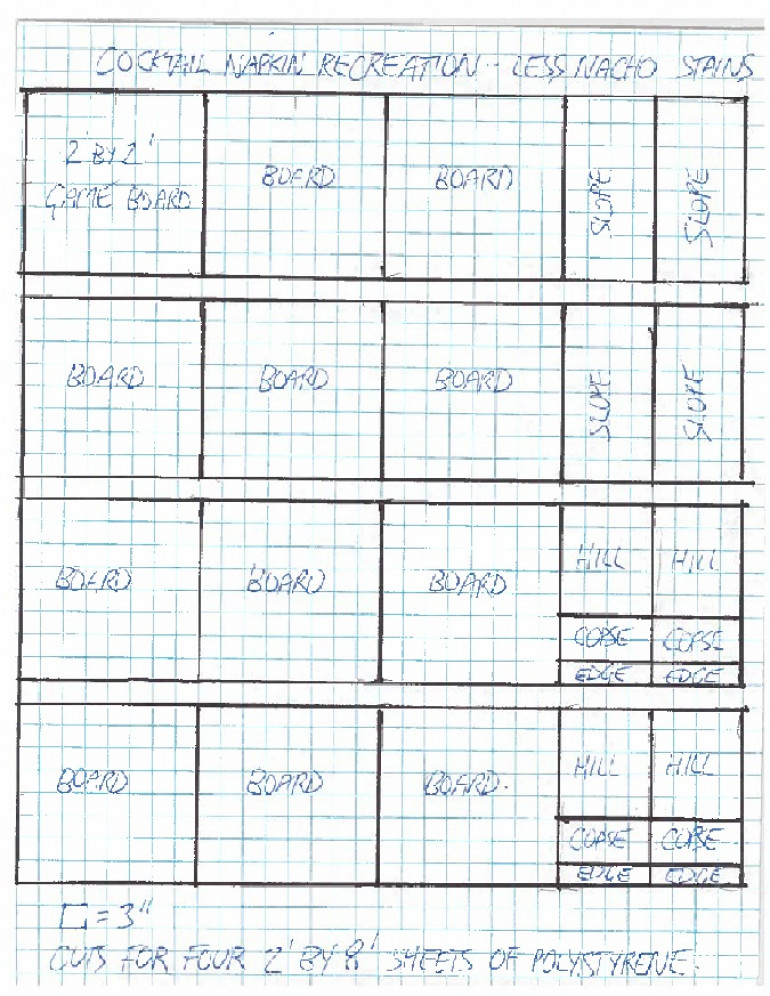 Tentative plan to turn four sheets of polystyrene insulation into twelve battle boards and scatter terrain.
Tentative plan to turn four sheets of polystyrene insulation into twelve battle boards and scatter terrain.I’ve since added some individual trees to the project as I thought the copses and hills weren’t enough to fill two tables. Keep in mind that this is an initial bare-bones build, and that I will be plugging in other pieces next winter, starting with some sci-fi scatter terrain, followed by a modular castle, and then a medieval village. I’ll post all relevant how-to’s on here, along with any how-not-to’s (we learn more from failure than success), epiphanies, and creative flares of profanity.
Parameters: As mentioned, the boards needed to be somewhat geomorphic, to create interesting and varied landscapes. Other factors were:
1. Maximum playable space. Herein lies the fundamental difference between a diorama and a game table. While it’s great to throw together great sprawling forests and huge rockwork landscapes, in the end it’s just unusable space. Also, steps and climbable rockwork would need to accommodate a 32mm base, minimum.
2. Contours would be a function of the scatter terrain, not the boards, meaning that the flat boards would stay flat, and not be carved into shallow depressions and crests. A pet peeve of the client, and frankly one of mine as well, is that it looks bad trying to rank up models on an uneven surface, or one studded with gravel or other annoying gubbins… another difference between a game table and a diorama.
3. The terrain needed to be generic, as opposed to genre specific, so it could be used for fantasy or sci-fi gaming, or even historical battles. I built some ancient ruins into the hills here and there, but resisted the temptation of putting in old helmets, shields, discarded bolters, etc.
4. The boards had to be robust. In my own experience gamers take terrain for granted. If it’s not theirs it’s meant to be tipped, dropped, bumped, leaned on, spilled on, puked on, and chipped. I needed to figure out a way to mitigate any *ding, blue foam* events.
5. Budget… doesn’t it always come down to that?
Materials
 A few of the materials I tested while looking for cheaper alternatives. Some good, some not so much.
A few of the materials I tested while looking for cheaper alternatives. Some good, some not so much.1. Four sheets of the aforementioned polystyrene, 2’by 8’, 1½” thick (approx. $30 Canadian a sheet). Rumour has it you can also use it to insulate your home.
2. About 2 liters of PVA or wood glue
3. Glue gun and gobs of glue sticks!
4. A bag of moss. I used Woodland Scenics, which was about $25 Canadian. I had about half of it left after all was said and done. I’m sure there are cheaper alternatives out there. You’ll need glycerin to keep it from crumbling like autumn leaves after it’s stuck to your trees.
5. Flock, assorted shades and textures. The Woodland Scenics coarse blend is great for adding texture and won’t ‘tilt’ model bases. In forested areas I used ground up Spanish moss as ground cover. Cheap enough at any dollar store or florist.
 Flat terrain doesn't have to be boring... said the guy from the prairies. Woodland Scenics products make for a diverse and realistic landscape.
Flat terrain doesn't have to be boring... said the guy from the prairies. Woodland Scenics products make for a diverse and realistic landscape.6. Sand for areas devoid of vegetation.
7. Gravel. The key is to use different-sized pebbles to make your rockwork look natural. I have an abandoned quarry a mile from the house, so a no-brainer for sourcing. Pebble size should be ½” or less. You should use polystyrene scraps for any bigger ‘rocks’, else you’ll end up with a hernia when you schlepp your boards to a gaming event.
 Spanish Moss. Ground up, it's great for forest floor terrain, and can also be used as tree foliage in savannah or jungle landscapes.
Spanish Moss. Ground up, it's great for forest floor terrain, and can also be used as tree foliage in savannah or jungle landscapes.8. Craft paint: six 4 oz. bottles of DecoArt Tan, and probably eight of the Christmas Green. They’re about $1.25 here. Alternately, you could buy two quarts of Latex, but it will cost more. You’ll be making dark washes out of brown/black craft paint, water, and dish soap… or you can get a second mortgage and use a quart of Nuln Oil and Agrax Earthshade.
9. Plasticard for edging boards and basing scatter terrain. It’s cheaper than MDF, and because it’s thinner, it makes a base sit tighter to the board and not look like a side plate piled with salad. Don’t buy the blank hobby plasticard; buy cheaper dollar store signs instead. A clerk may question your sanity when you buy a dozen ‘For Rent’ signs, but you can pre-empt that awkward conversation by showing up in a bib and a hockey helmet.

































![How To Paint Moonstone’s Nanny | Goblin King Games [7 Days Early Access]](https://images.beastsofwar.com/2024/12/3CU-Gobin-King-Games-Moonstone-Shades-Nanny-coverimage-225-127.jpg)

















